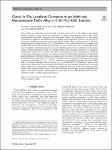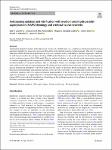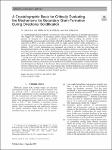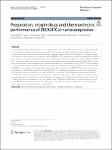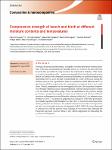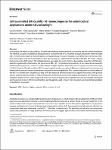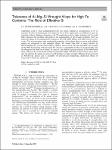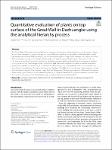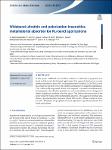Search
Author
- Manyk, T. (3)
- Murawski, K. (3)
- Baumgartner, Jörg (2)
- Guizani, Chamseddine (2)
- next >
Subject
Date issued
- 2023 (187)
Has File(s)
- true (187)
Search Results
Quasi-In Situ Localized Corrosion of an Additively Manufactured FeCo Alloy in 5 Wt Pct NaCl Solution FeCo alloys are important materials used in pumps and motors in the offshore oil and gas drilling industry. These alloys are subjected to marine environments with a high NaCl concentration, therefore, corrosion and catastrophic failure are anticipated. So, the surface dissolution of additively manufactured FeCo samples is investigated in a quasi-in situ manner, in particular, the pitting corrosion in 5.0 wt pct NaCl solution. The local dissolution of the same sample region is monitored after 24, 72, and 168 hours. Here, the formation of rectangular and circular pits of ultra-fine dimensions (less than 0.5 µm) is observed with increasing immersion time. In addition, the formation of a corrosion-inhibiting surface layer is detected on the sample surface. |
Electrical transport properties of YBa2Cu3Oy implanted by CdS nanoparticles nanoparticle size effect Cadmium sulfide nanoparticles size effects on the superconducting properties of YBa2Cu3Oy compound were investigated in details. Solid-state reaction method was used for the synthesis of samples with additional amounts of CdS nanoparticles with sizes 6 nm and 12 nm and an additional amount x = 0.1 wt%. Synthesis of cadmium nanoparticles was done by using aqueous methods and they were characterized by using transmission electron microscopy (TEM), X-ray diffraction (XRD). Optical absorption measurement of the as-synthesized nanoparticles was carried out, and the specific surface areas of the sample were analyzed using a surface area and porosity analyzer. Electrical resistivity and transport critical current densities were measured by using the four-probe technique. The measurements r... |
Anticipating qualitative changes in the rheological response of complex fluids (e.g., a gelation or vitrification transition) is an important capability for processing operations that utilize such materials in real-world environments. One class of complex fluids that exhibits distinct rheological states are soft glassy materials such as colloidal gels and clay dispersions, which can be well characterized by the soft glassy rheology (SGR) model. We first solve the model equations for the time-dependent, weakly nonlinear response of the SGR model. With this analytical solution, we show that the weak nonlinearities measured via medium amplitude parallel superposition (MAPS) rheology can be used to anticipate the rheological aging transitions in the linear response of soft glassy materi... |
A crystallography-based method is presented for the critical appraisal of possible mechanisms that trigger the formation of secondary grains during directional solidification. The method permits an analysis of a large population of defects, while avoiding the pitfalls of the metallographic sectioning approach that is affected by dendrite stereology. Here, the nickel-base superalloy CMSX-4, an alloy commonly used for single crystal turbine blade applications, is studied. All secondary grains originate exclusively at the external surface and when the off-axial primary ⟨001⟩
crystal orientations are measured, are evident at both the converging and diverging dispositions of the single crystal primary dendrites without a noticeable bias. Almost all of the secondary grains have low miso... |
Incorporating inorganic nanomaterials into a polymer matrix is one of the most effective ways to create thermoelectric performance for applications where physical flexibility is essential. In this study, flexible thermoelectric nanocomposite films were synthesized by incorporating inorganic copper iodide (CuI) nanosheets as the filler into poly (3,4-ethylene dioxythiophene): poly (styrene sulfonate) (PEDOT: PSS). The process involved the preparation of bulk CuI from precursors and, subsequently, the nanosheet synthesis by dissolving the bulk CuI in dimethyl sulfoxide (DMSO). The morphology of the nanosheets and the nanocomposite films was thoroughly examined, and the film’s thermoelectric performance was evaluated using a standard thermoelectric measurement system, ZEM-3. |
Owing to increased environmental demands to replace petroleum-derived materials with more environmentally friendly materials, research has been directed towards the potential of using wood in the automotive industry. This study extensively investigates the compressive strength (fc) of two hardwood species (beech and birch) with different anatomical directions, at various moisture and temperature levels, in an attempt to understand the wood’s behaviour during the forming process. The experimental tests were performed at 20, 100 and 140 °C on specimens with five moisture levels, ranging from completely dry to wet conditions. Overall, irrespective of the investigated direction, the measured compressive strength exhibited a clear exponential trend with increasing moisture content over t... |
In this paper, we report on the synthesis of a new hybrid photocatalytic material activated by natural sunlight irradiation. The material consists of multiferroic nanoparticles of bismuth ferrite (BFO) modified through the growth of the Fe-based MIL-101 framework. Material characterization, conducted using various techniques (X-ray diffraction, transmission electron microscopy, FTIR, and X-ray photoelectron spectroscopies), confirmed the growth of the MIL-101 metal–organic framework on the BFO surface. The obtained system possesses the intrinsic photo-degradative properties of BFO nanoparticles significantly enhanced by the presence of MIL-101. |
Aluminum scrap is often contaminated with steel parts, leading to accumulation of Fe in recycled Al alloys. Consequently, low limits for Fe in Al wrought alloys are difficult to meet by recycling without dilution with primary Al. Wrought alloys with a higher tolerance for Fe could help overcome this problem and improve the sustainability of Al wrought products. Here we study the effects of increasing the Fe content in EN AW-6060, 6005A, and 6082 from 0.2 to 0.7 wt pct. The microstructure and mechanical properties of the alloys after extrusion and artificial ageing are compared to the standard alloys. We found that 6082 is more tolerant to above-standard Fe contents than 6005A, which in turn is more tolerant than 6060: the strength of the 6082-based alloy with increased Fe content is... |
The Great Wall of China was a military facility that has been continuously built and used for over thousands of years, and is a world-renowned cultural heritage site today. The plants growing on top surface of the Great Wall caused the damage of the Great Wall, but the process of removing these plants may further damage the body of the Great Wall. In this paper, based on the Analytic Hierarchy Process and the expert Delphi method, we selected 13 specific indices from three Constraint Layer factors, and then estimated and identified 45 species/categories of plants on top surface of the Dazhuangke section of the Great Wall. The results showthe constitution and the evaluation gradeof the evaluation system. The factor of Disruptive Effects plays the main guidance role in the evaluation ... |
In this paper, wideband, and ultrathin metamaterial absorber is proposed, analyzed and fabricated for Ku-band applications. The reported absorber has a nearly perfect absorptivity above 90% covering the entire Ku band (12–20 GHz) at normal incidence for both transverse electric and transverse magnetic polarization. This is due to the supported electric and magnetic resonances simultaneously. Consequently, the effective permittivity and permeability can be designed to obtain impedance matching with free space. This leads to the absorption of the entire incident energy in the metamaterial absorber. The suggested structure also shows a good absorption response (above 80%) under oblique incidence (from 0 to 50°). Therefore, the proposed absorber represents a good potential for Ku-band a... |

